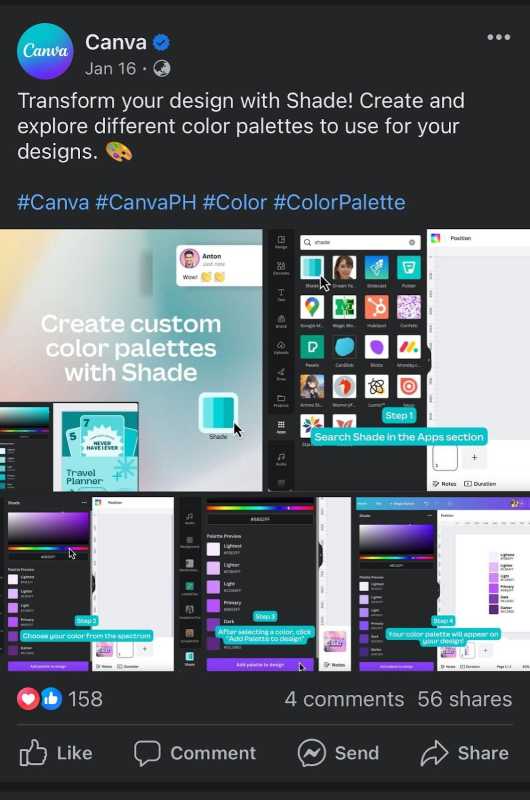Anytime anyone asks, “What is content marketing?” I always like to tell the origin story of the Michelin Star. People are often surprised to hear that the Michelin behind the certification that showcases the best restaurants in an area and the Michelin behind the tire company are one and the same.
Around 1900, the Michelin Tire Company was struggling to think up new ways to get people to buy their tires. So, instead of going the usual route of putting up print ads in newspapers, the owners created a guide to the best restaurants around town and marked them with a star to encourage people to drive around more and, therefore, need new tires more often.
They printed thousands of copies of the guide, which also included maps to the restaurants. Eventually, the plan worked: Michelin saw increases in profits, and the Michelin Guide and Star live on to this day.
The Michelin Guide was—and still is—one of the best examples of content marketing in history. It gave people useful information (e.g., restaurant maps) and established the company’s credibility, therefore building its brand authority. That’s content marketing at its core: It uses content to build trust and get more customers organically interested in your brand.
Learn more below about the definition of content marketing, how it works, and how to leverage it for your small business.
What Content Marketing Is
The simplest way to define content marketing is it’s a marketing strategy that uses content to draw audiences in and get them interested in your brand in organic ways. Content marketing is also sometimes called “inbound marketing” because it’s not outbound or intrusive like paid advertising or cold calls. Instead, it organically draws audiences in through valuable content, which in turn establishes their trust in your business and builds your brand presence.
Consider the Michelin example: Instead of putting up posters simply telling people to buy their tires or going door-to-door, the owners understood those wouldn’t be enough to truly motivate people to be interested in their brand. So instead, they used content to create a need that would drive people to buy more tires. It’s a longer, less straightforward form of marketing, but it’s one built on real, organic trust rather than superficial incentives.
How Content Marketing Works
The key to what makes content marketing work is it’s not all about your brand. It’s about your audience and their needs, wants, and pain points, and then addressing those needs and wants through valuable content. Doing so organically builds audiences’ trust in your brand.
Content marketing works because it’s a more organic way to communicate with audiences than traditional marketing like digital and print ads or television and radio commercials, which rely on a more intrusive and “hard sell” form of communication, usually to a disinterested audience. For instance, if you heard a radio ad for a home repair service interrupting your DJ’s morning show, you probably wouldn’t pay it much mind. In fact, you might even find it annoying.
In contrast, if you were trying to fix a leaky faucet at home and then found a YouTube video by a home repair service clearly outlining the solution, you would probably find it very helpful and find the company behind it to be credible. You might even be interested in knowing more about it. That’s how content marketing works: it uses valuable content, whether blogs, videos, or even podcasts, to instill people’s interest and trust in your brand.
Types of Content Marketing (+ Examples)
When it comes to making content for marketing, it’s important to understand that it’s not just about making any kind of content and then hoping it catches your audience’s attention. That might happen in a perfect world, but in reality, you’re competing with thousands of other brands creating millions of content. So how does yours stand out?
The key is knowing and understanding your audience’s needs and wants. The purpose of content marketing is to offer valuable content to your audience that would naturally draw them to your brand in an organic, non-intrusive way.
If you’re wondering exactly what content in marketing is, how it works, and what it looks like, keep reading below to learn the main types of content in marketing, along with some examples showing how they work:
1. Blogs: GoHenry’s Finance Blog
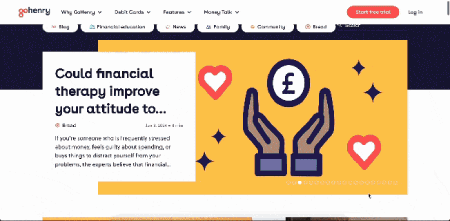
Blogs are the foremost form of content marketing, like this one from GoHenry. (Source: GoHenry)
GoHenry is a UK-based tech startup whose product is a financial management app specifically for children. It’s unique in that, while its user base is elementary-aged children, the targets of its marketing efforts are the parents who pay for those kids. Financial apps aren’t the most instantly appealing product to market to consumers, so instead, the team turned to blogging to get the word out about their brand and what their product does.
GoHenry also knows that simply talking about their product and how good it is won’t get them the attention they want from their customers. So in their blog, they pinpointed their target consumers’ common questions, needs, and issues instead, then used them as talking points for their content. You’ll find blogs explaining financial concepts in simple ways, tips on financial management, and even how-to guides.
All these subjects fall along the topics that their target audience would likely be thinking about and researching. And once they discover their blog (with the help of some good search engine optimization (SEO) marketing), they’re only a few steps away from converting into leads. It’s for this reason that starting a business blog is the foremost content marketing strategy for any small business. It increases your site’s visibility and authority and brings in high-value leads.
2. Video: Chewy’s YouTube channel
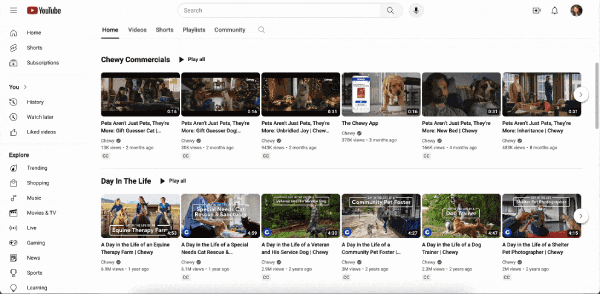
Chewy’s YouTube channel offers dozens of helpful content for pet owners, from how-to’s to vet Q&As. (Source: YouTube)
Content marketing isn’t reserved only for written content the way it was in the 1800s with the Michelin Guide. Today, you’ll find many marketers attesting to the power of video in growing online brand awareness. That’s because it’s true: video can even increase your click-through rate (CTR) by 41% more than text.
One of the best examples of video content marketing for businesses is from the pet retailer brand Chewy. On their YouTube channel, you’ll find dozens of instructional videos on all things pet care, from getting rid of fleas to DIY pet treats. But it’s not all just instructional content: they also have Q&A videos with licensed veterinarians and even day-in-the-life features of their team members.
Altogether, it creates a helpful knowledge base for their target audience of pet owners while fostering a sense of community. It’s one of the best examples of YouTube content marketing overall. By knowing the needs and interests of their audience, Chewy’s able to foster a sense of kinship while establishing their brand as an authority—a steadfast combination for brand loyalty.
3. Social Media Content: Canva’s Facebook & Instagram Profiles
You probably know Canva as the online graphic design platform with millions of users, but it’s hard to believe that merely a decade ago not many people had heard of it. You can thank Canva’s social media marketing strategy for that rapid growth, which largely revolves around making useful content for its users.
Scrolling through Canva’s Facebook or Instagram pages, you’ll find many posts with design tips for beginners, new templates and how to use them, and even how-to videos on designing certain projects. It’s the kind of content that their user base—design beginners and small business owners—would find helpful when using their platform.
And, because their product is an online platform (unlike tangible products like apparel), social media’s visual nature is a huge benefit. It’s one of those instances when showing instead of telling is far more effective: instead of explaining how their platform works through wordy paragraphs, Canva uses infographics, short-form videos, and image carousels, which are all easily accessible on social media. This makes the brand easy for its audience to connect to.
4. Email: Netflix’s Email Newsletter

Email offers a more focused way of communicating with your audiences, perfect for newsletters like this from Netflix. (Source: Netflix)
Before social media, there was email. And today, email’s still a well-loved fixture in content marketing because it has a significant advantage over others: instead of competing with hundreds of other brands for your audience’s attention like with social media or Google, email is a far more focused platform. Once recipients open your email, you have their attention for the whole page.
Emails also allow for longer information instead of short bite-sized content. All these features make it an excellent channel for engaging content, like newsletters. One of the best examples is Netflix’s email newsletter to its subscribers telling about upcoming releases on the platform. It’s a simple but effective way of keeping subscribers coming back to their TV screens, i.e., keeping them engaged with the brand.
Even if your business isn’t a global streaming service, you can still get many benefits from email content marketing. For instance, send monthly or weekly newsletters highlighting your best blogs, or offer exclusive deals to email-only subscribers. Email campaigns like these can build an engaged audience for your business, and even a loyal customer base. Find out more about email marketing for your small business.
5. Podcasts: Headspace’s Radio Headspace Podcast
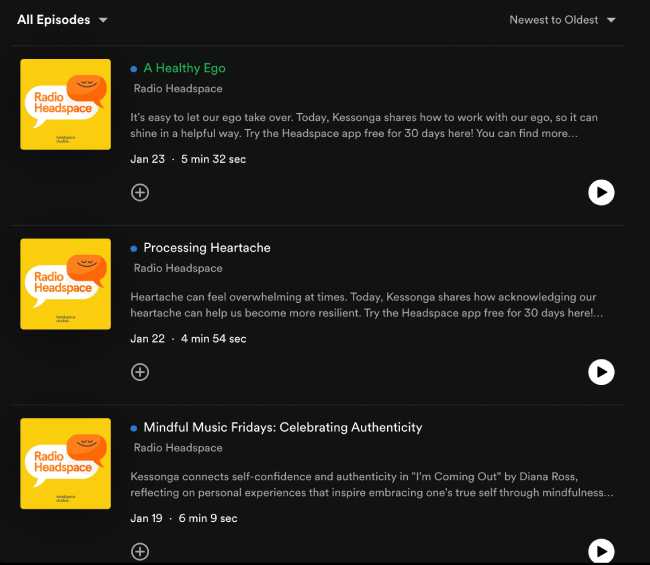
Headspace’s podcast is a great example of podcast content marketing that builds credibility. (Source: Spotify)
Podcasts are a relatively new entry into the content marketing world, and they’re already proving an impactful one. One of the best examples today is from Headspace, the online wellness and meditation app. As a tech platform, Headspace’s biggest challenge is educating people about their product, and more importantly, getting them interested enough to be full subscribers.
Headspace could simply tell people about what meditation and wellness are and why they’re important, but hundreds of blogs already cover that topic. And ultimately, they’re not always convincing enough to convert people into subscribers. So, they used another way to get into people’s heads: audio, through podcasts.
Headspace’s podcasts discuss topics on meditation and mental wellness but in a more conversational way. Podcasts are also simpler to absorb (for instance, people can listen to them while driving). Specifically, they also offer valuable tips on managing mental health more effectively and even invite wellness experts to interview as guests. These help position Headspace’s credibility and authority in the wellness space.
6. Webinars: Sephora’s #SephoraEvents

Cosmetic retailer Sephora regularly hosts exclusive live webinars for its member community. (Source: Sephora Events)
Videos are some of the most effective types of content in marketing. That’s even more true with live videos like webinars. Webinars are especially effective because people come to webinars already expecting to learn something new. So when you host a webinar, you’re already speaking to a captive and interested audience who find your brand credible.
That’s the biggest difference between webinars and regular videos. Webinars grant you a real live audience you have direct contact with, and they’re also effective at generating leads. A great example of this is cosmetics retailer Sephora’s webinar series, which invites experts and founders to give tutorials and discuss industry updates to their audience of cosmetics enthusiasts.
What also makes Sephora’s webinars unique is they’re exclusive to Sephora members, which gives them a higher sense of prestige. It incentivizes audiences to be part of this exclusive club and gain access to industry experts. At the same time, it keeps existing members coming back for more.
7. E-books & Whitepapers: HubSpot
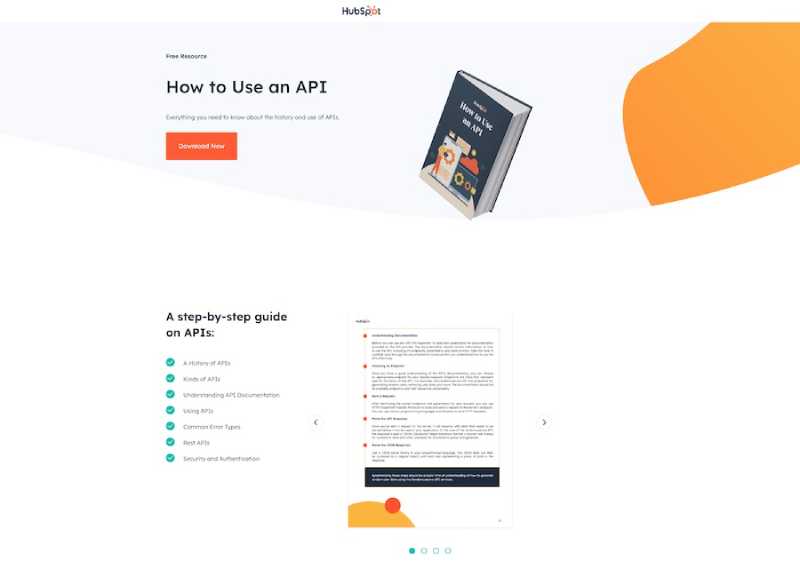
Downloadable books like HubSpot’s free template give your audience a piece of your brand to download and keep. (Source: HubSpot)
Sure, your audiences can read your blog and learn about your brand online, but how can you be sure they’ll still remember you once they close their tabs? That’s where downloadables like e-books and whitepapers come in handy. Downloadable content gives your audience a piece of your brand they can download and keep wherever they go.
The key to making downloadable content work is to ensure they’re valuable enough for your audience to download. Your e-book or whitepaper should cover relevant topics in your industry or address your audience’s questions or concerns. For example, software provider HubSpot published an e-book on how to use an API (an application programming interface), which is a significant issue for many of its users.
HubSpot’s e-book works because the subject matter is right up HubSpot’s alley. HubSpot sells software and APIs to small business owners who may not always know how APIs work. And because the subject can be lengthy, they published an e-book detailing step-by-step instructions. This simultaneously gives their target audience valuable information and establishes them as an authoritative source.
8. Experiential Marketing: Spotify Wrapped
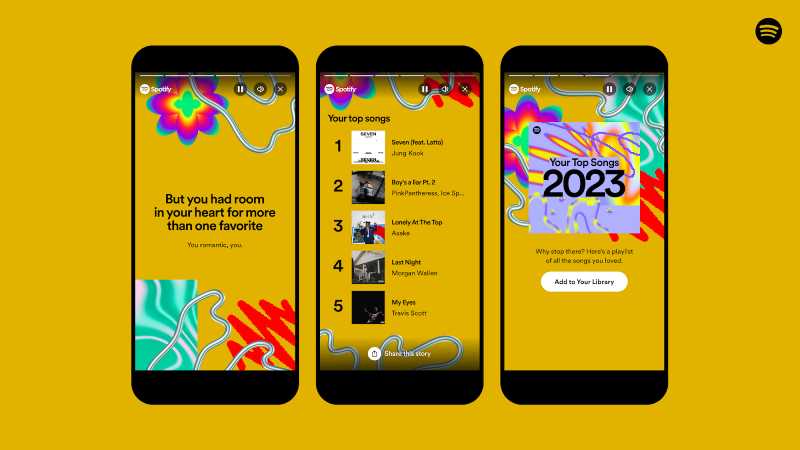
One of the most popular forms of experiential content marketing: Spotify’s Wrapped campaign. (Source: Spotify)
Experiential marketing is a strategy that connects brands with audiences via experiences (hence its name). As a content marketing strategy, it means specifically creating content users can experience and interact with, like Spotify’s Wrapped campaign, which is a more unique example of content marketing that’s unlike the other examples above.
For the uninitiated, Spotify Wrapped is the app’s annual end-of-year campaign showing its users’ listening behavior, including their top artists, genres, and so on. At its core, the campaign hinges entirely on user content—it just presents it in a creative and shareable format. This transforms the data from something audiences simply absorb into something they can interact with. It fosters engagement, which in turn fosters brand recall.
Your business’ experiential content marketing campaign doesn’t have to be as complex or ambitious. It can be as simple as interactive infographics or reports, or adding polls and surveys in your blogs. Fun, interactive features like these make your content more engaging and therefore more memorable.
Other Content Marketing Strategies
While the examples above are some of its most well-known forms, content marketing also covers other strategies and methods. These strategies don’t always involve content creation, but they share the same goal of using content to capture audiences’ attention. Here are some of the other strategies under content marketing:
- Link-building campaigns: This involves placing links to your website in other authoritative sites (also called “backlinking”). Doing so gives people more entry points into your website and builds its credibility and search engine ranking.
- Publishing case studies: While case studies usually also take the form of blogs, their content focuses specifically on success stories from previous customers of your brand. Publishing these stories increases your credibility to new audiences.
- Influencer outreach: One of the newer forms of social media marketing, influencer marketing involves connecting with influential figures on social media platforms and then leveraging their clout to bring awareness to your brand. Influencer campaigns can be anything from simple product endorsements to contests and giveaways.
- User-generated content (UGC): This strategy involves using content from your customers to promote your brand, such as users’ content on social media or online reviews. UGC marketing is effective because it’s more authentic to audiences than traditional brand-to-consumer marketing, and therefore more credible.
- On- and off-page SEO: After publishing your content, particularly blogs, videos, and podcasts, you’ll need to do some extra work to make sure your audience finds them. This is where on- and off-page search engine optimization (SEO) comes in, which involves methods like keyword optimization, website user experience (UX) improvements, and increasing site speed, among others.
Benefits of Content Marketing
Can content marketing guide your business toward a greater brand presence? The answer is yes—with the right planning and strategy. As the examples above show, content marketing is diverse, but that only means it offers plenty of opportunities to get the word out about your brand. It’s also a good fit for small businesses because it’s cost-effective. You can get started with content marketing at completely zero cost.
Here are some of the other reasons and biggest benefits of content marketing for small businesses:
- It’s cost-effective: As mentioned, one of the best benefits of content marketing is its affordability. For instance, starting a blog can cost you almost nothing, as many blogging platforms are completely free. In fact, over half of marketers spend less than 50% of their marketing budget on content marketing. All it takes is a good content strategy and consistency.
- It’s sustainable: Unlike digital ads that have an expiry date, content marketing can go on for years and still bring value to your business. Articles and videos you published five years ago can still be updated to fit current landscapes, and can even be repurposed into other forms of content.
- It’s accessible: You don’t need to be a specialist of any kind to get started with content marketing. Once you master the basics of your content marketing platform (e.g., search engines, social media, email, etc.), you can easily start your content marketing strategy.
- Customers prefer content over ads: According to the Content Marketing Institute, over 70% of consumers prefer learning about brands and products through content than ads. It’s not surprising: ads are everywhere, good content isn’t. That instantly makes it more valuable and credible to customers.
- It generates revenue and builds brand trust: Finally, content marketing directly helps generate revenue and trust. Another study found that customers who consume educational content from a brand in the early stages are 131% more likely to follow through with a purchase. Not only that, they’re also up to 64% more likely to find the brand trustworthy.
How to Get Started With Content Marketing
Now that you have a general idea of what content marketing is and what makes it work, the next step is to get started doing it for your business. Content marketing can take many forms on many platforms, and the key is to find the best combination for your business. Here are some steps to help you get started with content marketing:
- Outline your objectives: Before creating any kind of content, you’ll need a main objective for your entire campaign. This can be anything from growing your brand awareness on social media and increasing your website traffic, to generating more leads. Your main objective will guide the rest of your campaign.
- Research your target audience: We’ve emphasized how much of content marketing success hinges on understanding your audiences’ interests, needs, and wants. The only way to do that is to research them: how they behave and communicate online, what they’re searching for, and their biggest questions and pain points, along with regular demographic points like age and location.
- Choose the best content type(s): While there are many content types to choose from, not all will be the best fit for your business. You’ll need to zero in on those that best serve your needs. For example, if your goal is to increase your website traffic, blogging will likely be your best strategy, while email marketing is better at retaining customers.
- Plan your content strategy: Strategy is the second-most important variable in your content marketing’s success after audience research. This involves brainstorming content ideas, planning a content calendar, and developing your content’s style and voice.
- Set metrics of measurement: To evaluate the effectiveness of your strategy (or if you need to pivot and recalibrate), you’ll need to set clear metrics to measure against. These should also follow your main objectives. Some common content marketing metrics are engagement rates for social media, page traffic for blogs, and open-and-click rates for emails.
Like any marketing strategy, content marketing management is a process of trial, error, and learning. No two content strategies are the same for any business. The tips above will help you get started, but you’ll also need to learn and recalibrate as you go to better cater to your audience and meet your goals.
Frequently Asked Questions
Content marketing is a marketing strategy that uses content to organically draw audiences in and get them interested in your business. This content can be blogs, videos, infographics, emails, webinars, or other helpful content that addresses your audience’s needs, wants, and interests. Content marketing works when audiences naturally become interested in your content and become customers of your brand.
Content marketers plan and execute content strategies that specifically address a brand’s marketing needs. Their tasks include doing audience research, planning content calendars, creating content (whether writing blogs, producing videos and podcasts, or designing infographics), publishing content, and measuring results. They can also do other content marketing tasks like link-building campaigns and influencer outreach.
Some common examples of marketing content are educational or instructional blogs, tutorial videos, product demos, social media infographics, email newsletters, and podcasts and webinars discussing topics in a certain industry. The common denominator is they all come from brands and discuss topics that are relevant to their target audience and offer them real value.
Bottom Line
Answering “What is content marketing?” doesn’t come down to one specific format or description. Content marketing can be a blog, a video, or even a podcast. More accurately, it comes down to offering real value to your audience through content and then transferring their interest to your brand. When done right, content marketing can build your brand’s long-term credibility and create loyal connections with your customers.


